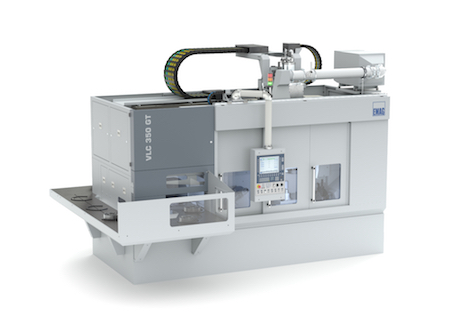Perform Two Gear-Machining Processes in One Clamping
Both a grinding and a turning machine, EMAG’s VLC 350 GT speeds transmission component production by enabling multiple machining processes of chucked parts in a single clamping operation.
Posted: April 7, 2021
By integrating multiple grinding spindles with an NC swiveling axis, the VLC 350 GT (for “grinding” and “turning”) from EMAG LLC (Farmington Hills, MI) performs multiple successive gear-machining processes with one clamping operation. Suitable for workpieces up to 14 inches (350 mm) in diameter, the machine enables:
End face turning: Loading and subsequent unloading is performed at high speeds with a pick-up spindle. Machining starts with hard turning of the end faces.
Contour turning: Depending on geometry, inner contours (with one or two tapers), a cylindrical borehole, and the outer synchronizing taper can be preturned in the second step.
Inner contour grinding: A cylindrical grinding element on the swiveling NC axis makes it possible to machine internal taper angles. Boreholes are completed in this way, with a zero-degree grinding angle.
Outer counter grinding: The final operation consists of grinding the outer synchronizing taper with the external grinding spindle.
Manufacturers that want to machine parts with different bore holes can use two internal grinding spindles: one for smaller borehole diameters, which require high speeds; the other for lower-speed large-borehole diameters.
Residual machining allowance after turning is a few millimeters. Using corundum or CBN grinding wheels significantly shortens grinding times. Integrated measuring probe checks component diameter and length after the process. A linear motor in the X-axis shortens chip-to-chip times by swiftly moving components to the machining position.
















